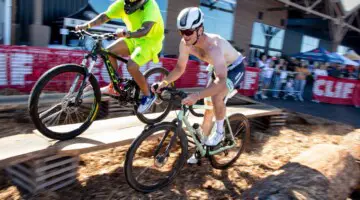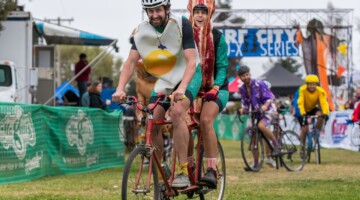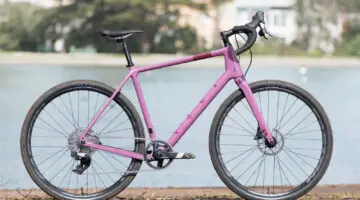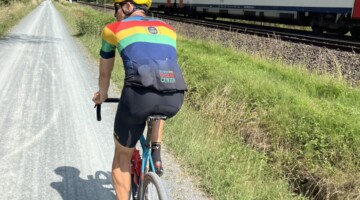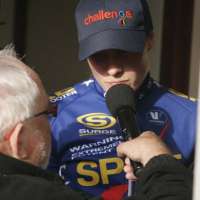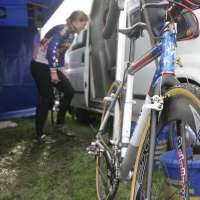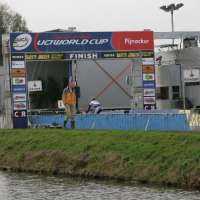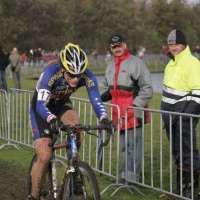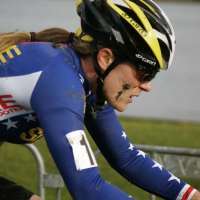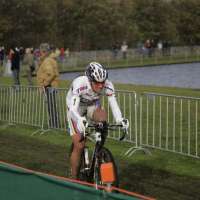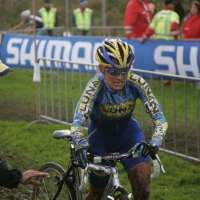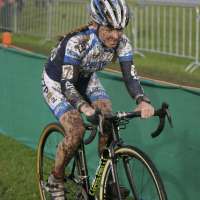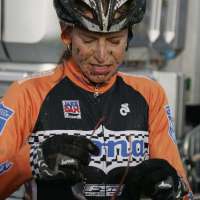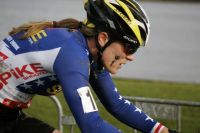 Spike Shooter’s Katie Compton has already had a season of ups and downs, having started the season undefeated in the U.S. but then pulling out in her first World Cup in Kalmthout and later skipping the Boulder Cup Weekend. We caught up with her husband Mark Legg-Compton for an update on Katie’s racing and her ongoing leg (no pun intended) issues, and a personal race report from Pijnacker.
Spike Shooter’s Katie Compton has already had a season of ups and downs, having started the season undefeated in the U.S. but then pulling out in her first World Cup in Kalmthout and later skipping the Boulder Cup Weekend. We caught up with her husband Mark Legg-Compton for an update on Katie’s racing and her ongoing leg (no pun intended) issues, and a personal race report from Pijnacker.
CXM: Katie didn’t make the Boulder Cup, but you guys were in Colorado. What happened?
MLC: After Katie’s leg issues at her first World Cup in Kalmthout, she decided to skip the Boulder Cup. She could have raced on the weekend but she elected not to because we were flying to Belgium the next Tuesday. We didn’t want a hard effort in her legs before flying which is a contributing factor to her legs cramping.
CXM: Is her leg problem from the Ohio crash, or is it the same problem she’s had for a while?
MLC: It’s the same disorder as Worlds and the same that has been plaguing her since she was a teenager. There are varying degrees of the disorder but the result is always the same.
CXM: Any more luck with diagnosing or curing the problem?
MLC: We are going to try and see one of the few metabolic disorder specialists in the nation next spring. Unfortunately the way the U.S. medical system works it’s very hard to see a specialist and deal with insurance. It would be cheaper for us to fly to New Zealand for treatment than here, which we are considering.
CXM: What are her plans for the rest of the season?
MLC: We fly to Belgium for three weeks then return to the U.S. for Nationals then return immediately for the Nommay World Cup and stay through Worlds so Katie can avoid flying which can start off her leg cramping. Needless to say being a professional cyclist and flying are requirements for the job which makes it bit of an extra challenge.
CXM: When Katie suffers from this problem, what does she do to recover? Ride easy? Bed rest?
MLC: When Katie is suffering from an episode the only activity she can handle is minor walking with the dogs but that’s not always the case. Generally episodes last from 10 days to 21 days which creates a lot of de-training during this period since no activity can be performed. We’ve been receiving emails from around the country from other cyclists who appear to be suffering from very similar symptoms but they like Katie are undiagnosed.
________________________
Mark’s Pijnacker Race Report
After the disappointment of the Kalmthout World Cup, we arrived in Belgium looking to make up the valuable UCI points we missed at the first WC in Kalmthout. Pijnacker would be the first test for Katie, as she’s had nearly four weeks of not breathing hard either in races or in training. We took a very slow return to training to allow Katie’s legs to fully recover.
Pijnacker translates to “the field of pain” which is about right for this mud powerfest of epic proportions.
How it unfolded:
After a third row start alongside Katerina Nash of Luna, Katie powered her way up to the head of the race outpacing the World Champion Hanka Kupernagel on the first stair section before the first pit. After passing by the pit, Katie easily rode by race leader Saskia Elemans, slowly dragging out a slender lead. Saskia and Hanka both crashed in a difficult mud rutted section allowing Katie to open up a sizable lead. With a 22 second lead, Katie crashed on lap two right before the stair section where she ran with her bike to the top with a sightly smaller lead. Her bad luck wasn’t over-coming into the pit on the second lap Katie dropped her bike, but the bike bounced off the catcher and landed on the fresh bike, tangling the handlebars in the rear wheel. It took a few precious seconds to untangle the two bikes allowing Hanka make up time when she elected not to pit. Katie applied the pressure again to make up for lost time and moved out the time gap a few extra seconds which she maintained for the remainder of the lap. However, the World Champion closed down the gap to Katie, and the two rode together for a while with Hanka at the front.
Heading into the stairs on the last lap Katie crashed into the fencing on the other side badly bruising her knee. She chased back to Hanka with the race announcer praising Katies toughness while also commenting on her strong shoulders, stating she must do a lot of weightlifting (she doesn’t do any resistance training off the bike). But Hanka was able to apply just enough pressure to detach Katie from her wheel.
Meanwhile, Katerina Nash had attacked out of the chase group after a slow start in her quest for the last podium place. With two American company-sponsored bike racers on the podium, the race displayed the current state of the very high quality American women’s cyclocross scene.
The silver lining:
On the last lap Katie was feeling the recent four weeks of not breathing hard on the bike and lost a lot of power in the heavy mud sections. Katie rode with an SRM wireless system for the race which indicated a large drop-off in power compared to power numbers at the 3 days of racing in Cincinnati. In a racing and training sense, this is a good sign as she can rebuild back to her original pre-cramping strength and yet she’s still able to compete for a World Cup win with reduced maximal and sustained power.
Photo Gallery:

